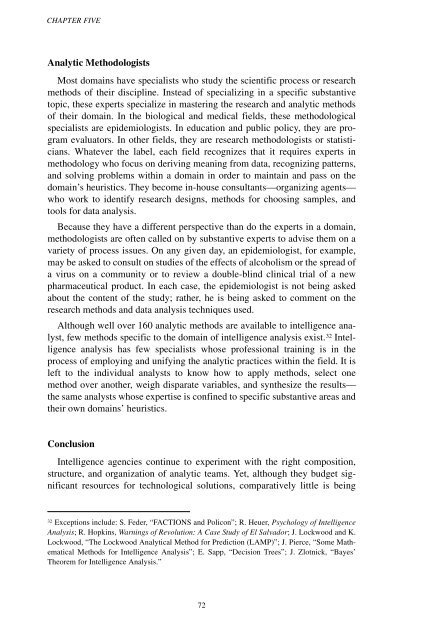Analytic Culture in the U.S. Intelligence Community (PDF) - CIA
Analytic Culture in the U.S. Intelligence Community (PDF) - CIA
Analytic Culture in the U.S. Intelligence Community (PDF) - CIA
You also want an ePaper? Increase the reach of your titles
YUMPU automatically turns print PDFs into web optimized ePapers that Google loves.
CHAPTER FIVE<br />
<strong>Analytic</strong> Methodologists<br />
Most doma<strong>in</strong>s have specialists who study <strong>the</strong> scientific process or research<br />
methods of <strong>the</strong>ir discipl<strong>in</strong>e. Instead of specializ<strong>in</strong>g <strong>in</strong> a specific substantive<br />
topic, <strong>the</strong>se experts specialize <strong>in</strong> master<strong>in</strong>g <strong>the</strong> research and analytic methods<br />
of <strong>the</strong>ir doma<strong>in</strong>. In <strong>the</strong> biological and medical fields, <strong>the</strong>se methodological<br />
specialists are epidemiologists. In education and public policy, <strong>the</strong>y are program<br />
evaluators. In o<strong>the</strong>r fields, <strong>the</strong>y are research methodologists or statisticians.<br />
Whatever <strong>the</strong> label, each field recognizes that it requires experts <strong>in</strong><br />
methodology who focus on deriv<strong>in</strong>g mean<strong>in</strong>g from data, recogniz<strong>in</strong>g patterns,<br />
and solv<strong>in</strong>g problems with<strong>in</strong> a doma<strong>in</strong> <strong>in</strong> order to ma<strong>in</strong>ta<strong>in</strong> and pass on <strong>the</strong><br />
doma<strong>in</strong>’s heuristics. They become <strong>in</strong>-house consultants—organiz<strong>in</strong>g agents—<br />
who work to identify research designs, methods for choos<strong>in</strong>g samples, and<br />
tools for data analysis.<br />
Because <strong>the</strong>y have a different perspective than do <strong>the</strong> experts <strong>in</strong> a doma<strong>in</strong>,<br />
methodologists are often called on by substantive experts to advise <strong>the</strong>m on a<br />
variety of process issues. On any given day, an epidemiologist, for example,<br />
may be asked to consult on studies of <strong>the</strong> effects of alcoholism or <strong>the</strong> spread of<br />
a virus on a community or to review a double-bl<strong>in</strong>d cl<strong>in</strong>ical trial of a new<br />
pharmaceutical product. In each case, <strong>the</strong> epidemiologist is not be<strong>in</strong>g asked<br />
about <strong>the</strong> content of <strong>the</strong> study; ra<strong>the</strong>r, he is be<strong>in</strong>g asked to comment on <strong>the</strong><br />
research methods and data analysis techniques used.<br />
Although well over 160 analytic methods are available to <strong>in</strong>telligence analyst,<br />
few methods specific to <strong>the</strong> doma<strong>in</strong> of <strong>in</strong>telligence analysis exist. 32 <strong>Intelligence</strong><br />
analysis has few specialists whose professional tra<strong>in</strong><strong>in</strong>g is <strong>in</strong> <strong>the</strong><br />
process of employ<strong>in</strong>g and unify<strong>in</strong>g <strong>the</strong> analytic practices with<strong>in</strong> <strong>the</strong> field. It is<br />
left to <strong>the</strong> <strong>in</strong>dividual analysts to know how to apply methods, select one<br />
method over ano<strong>the</strong>r, weigh disparate variables, and syn<strong>the</strong>size <strong>the</strong> results—<br />
<strong>the</strong> same analysts whose expertise is conf<strong>in</strong>ed to specific substantive areas and<br />
<strong>the</strong>ir own doma<strong>in</strong>s’ heuristics.<br />
Conclusion<br />
<strong>Intelligence</strong> agencies cont<strong>in</strong>ue to experiment with <strong>the</strong> right composition,<br />
structure, and organization of analytic teams. Yet, although <strong>the</strong>y budget significant<br />
resources for technological solutions, comparatively little is be<strong>in</strong>g<br />
32<br />
Exceptions <strong>in</strong>clude: S. Feder, “FACTIONS and Policon”; R. Heuer, Psychology of <strong>Intelligence</strong><br />
Analysis; R. Hopk<strong>in</strong>s, Warn<strong>in</strong>gs of Revolution: A Case Study of El Salvador; J. Lockwood and K.<br />
Lockwood, “The Lockwood <strong>Analytic</strong>al Method for Prediction (LAMP)”; J. Pierce, “Some Ma<strong>the</strong>matical<br />
Methods for <strong>Intelligence</strong> Analysis”; E. Sapp, “Decision Trees”; J. Zlotnick, “Bayes’<br />
Theorem for <strong>Intelligence</strong> Analysis.”<br />
72
















